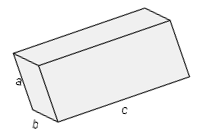This set of Casting, Forming and Welding Multiple Choice Questions & Answers (MCQs) focuses on “Pattern Design”.
1. The designing of a pattern does not include which of the following feature?
a) To locate the direction of the parting line and adjust the component accordingly
b) To determine regions and measurement of draft angles and radii of the sharp edges where allowances are to be given
c) To recognize and abolish the region of or where the defects could take place during casting
d) To 3D print the design for making the pattern
View Answer
Explanation: The printing of a design is executional operation of that casting design. The design is meant for study the casting structure and modify it accordingly if needed.
2. Calculate the size of cylindrical riser (height and dia equal) to feed a steel slab casting 25x25x5 cm.

a) 10cm
b) 12.5cm
c) 14cm
d) Data insufficient
View Answer
Explanation: a = 25cm b = 5cm c = 25cm
Modulus Mc = (a×b)/2(a+b) = Mc = (25×5)/2(25+5) = 125/60 = 2.0833cm
The riser diameter D = 6 x Mc = 6×2.0833 = 12.5cm.
3. Calculate the riser diameter for an annular cylinder of 30 cm outer diameter, 10 cm inner diameter and 30cm height. ( correction factor = 1.14)
a) 22cm
b) 20cm
c) 22.6cm
d) 20.6cm
View Answer
Explanation: Core dia = 10cm Plate thickness = 10cm Correction factor = 1.14

Riser Volume = 0.48 x 18849 = 907.52 cm3
∴ Riser diameter = 22.585cm = 22.6cm.
4. The relation between modulus of riser and modulus extension factor is __________
a) ![]()
b) ![]()
c) ![]()
d) ![]()
View Answer
Explanation: Mr` = 1.2⁄f Mc represents the correct relation between modulus of riser and modulus extension factor (MEF) where Mc is the modulus, f is the introduction factor or MEF and Mr` is the reduction in modulus. The MEF is required where the riser is required for longer times.
5. The preferred shape of a runner in a sand casting is ___________
a) Cylindrical
b) Spherical
c) Rectangular
d) Trapezoidal
View Answer
Explanation: Trapezoidal runner is most preferable in sound sand casting as it provides good flow with less distortion or splattering of molten metal.
6. Find out the error(s) in the following design of a casting.

a) The vertical faces must be tapered ( provide draft allowance) only
b) The cavity must be created using some additional elements ( loose piece) only
c) The vertical faces must be tapered as well as the cavity must be created using loose piece
d) Nothing needs to be done ( no error)
View Answer
Explanation: Draft allowances well as loose piece needs to be provided to the pattern in order to maintain the quality of the casting. The corrected design is drawn below:

7. Riser for a sand casting can be designed using ___________
a) Modulus method
b) Cained method
c) Naval research laboratory method
d) All of the mentioned
View Answer
Explanation: The three of these methods- modulus, Cained and NRLM are used to calculate and design Riser for a sand casting.
8. Rat tails and buckles in sand casting are caused by __________
a) Lower strength of the solidified metal
b) Lower refractoriness of the moulding sand
c) Lower strength of the moulding sand
d) Lower hardness of the moulding sand
View Answer
Explanation: Lower strength of the moulding sand causes rat tails and buckles type of defect in manufacturing of casting.
9. Which of the following diagram is best suitable for least stress generation at the bent(s)?
a)
b)
c)
d)
View Answer
Explanation: The diagram which has round filets around the inner as well as the outer corners, the tress generation will be least as compared to the other diagrams.
10. Parting line in the sand casting should be ___________
a) Simple and curved
b) Simple and straight
c) Irregular
d) Any type will not make a difference
View Answer
Explanation: The parting line needs to be simple and straight to create a difference between upper part and lower part.
Sanfoundry Global Education & Learning Series – Casting, Forming and Welding.
To practice all areas of Casting, Forming and Welding, here is complete set of 1000+ Multiple Choice Questions and Answers.
If you find a mistake in question / option / answer, kindly take a screenshot and email to [email protected]
- Practice Casting, Forming and Welding II MCQ
- Practice Mechanical Engineering MCQs
- Check Casting, Forming and Welding I Books
- Check Mechanical Engineering Books
- Apply for Metallurgical Engineering Internship
